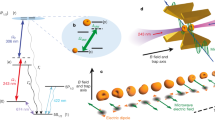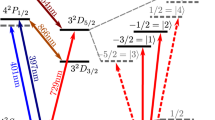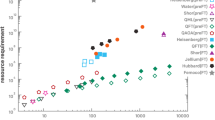Abstract
Entanglement lies at the heart of quantum mechanics, and in recent years has been identified as an essential resource for quantum information processing and computation1,2,3,4. The experimentally challenging production of highly entangled multi-particle states is therefore important for investigating both fundamental physics and practical applications. Here we report the creation of highly entangled states of neutral atoms trapped in the periodic potential of an optical lattice. Controlled collisions between individual neighbouring atoms are used to realize an array of quantum gates, with massively parallel operation. We observe a coherent entangling–disentangling evolution in the many-body system, depending on the phase shift acquired during the collision between neighbouring atoms. Such dynamics are indicative of highly entangled many-body states; moreover, these are formed in a single operational step, independent of the size of the system5,6.
This is a preview of subscription content, access via your institution
Access options
Subscribe to this journal
Receive 51 print issues and online access
$199.00 per year
only $3.90 per issue
Buy this article
- Purchase on Springer Link
- Instant access to full article PDF
Prices may be subject to local taxes which are calculated during checkout





Similar content being viewed by others
References
Gottesman, D. & Chuang, I. L. Demonstrating the viability of universal quantum computation using teleportation and single-qubit operations. Nature 402, 390–393 (1999)
Raussendorf, R. & Briegel, H. J. A one-way quantum computer. Phys. Rev. Lett. 86, 5188–5191 (2001)
Briegel, H. J., Calarco, T., Jaksch, D., Cirac, J. I. & Zoller, P. Quantum computing with neutral atoms. J. Mod. Opt. 47, 415–451 (2000)
Terhal, B. M., Wolf, M. M. & Doherty, A. C. Quantum entanglement: A modern perspective. Phys. Today 56, 46–52 (2003)
Jaksch, D., Briegel, H. J., Cirac, J. I., Gardiner, C. W. & Zoller, P. Entanglement of atoms via cold controlled collisions. Phys. Rev. Lett. 82, 1975–1978 (1999)
Briegel, H. J. & Raussendorf, R. Persistent entanglement in arrays of interacting particles. Phys. Rev. Lett. 86, 910–913 (2001)
Anderson, B. P. & Kasevich, M. A. Macroscopic quantum interference from atomic tunnel arrays. Science 282, 1686–1689 (1998)
Cataliotti, F. S. et al. Josephson junction arrays with Bose-Einstein condensates. Science 293, 843–846 (2001)
Jaksch, D., Bruder, C., Cirac, J. I., Gardiner, C. W. & Zoller, P. Cold bosonic atoms in optical lattices. Phys. Rev. Lett. 81, 3108–3111 (1998)
Greiner, M., Mandel, O., Esslinger, T., Hänsch, T. W. & Bloch, I. Quantum phase transition from a superfluid to a Mott insulator in a gas of ultracold atoms. Nature 415, 39–44 (2002)
Brennen, G., Caves, C. M., Jessen, P. S. & Deutsch, I. H. Quantum logic gates in optical lattices. Phys. Rev. Lett. 82, 1060–1063 (1999)
Sørensen, A. & Mølmer, K. Spin-spin interaction and spin squeezing in optical lattices. Phys. Rev. Lett. 83, 2274–2277 (1999)
Brennen, G., Song, D. & Williams, C. J. A quantum computer architecture using nonlocal interactions. Phys. Rev. A 67, 050302 (2003)
Pachos, J. K. & Knight, P. L. Quantum computation with a one-dimensional optical lattice. Preprint at 〈http://xxx.lanl.gov/quant-ph/0301084〉 (2003).
Feynman, R. P. Quantum mechanical computers. Opt. News 11, 11–20 (1985)
Feynman, R. P. Quantum mechanical computers. Found. Phys. 16, 507–531 (1986)
Jané, E., Vidal, G., Dür, W., Zoller, P. & Cirac, J. I. Simulation of quantum dynamics with quantum optical systems. Quant. Inform. Comput. 3, 15–37 (2003)
Mandel, O. et al. Coherent transport of neutral atoms in spin-dependent optical lattice potentials. Phys. Rev. Lett. 91, 010407 (2003)
Greiner, M., Mandel, O., Hänsch, T. W. & Bloch, I. Collapse and revival of the matter wave field of a Bose–Einstein condensate. Nature 419, 51–54 (2002)
Greenberger, D. M., Horne, M. A. & Zeilinger, A. in Bell's Theorem, Quantum Theory, and Conceptions of the Universe (ed. Kafatos, M.) 69–72 (Kluwer Academic, Dordrecht, 1989)
Kashurnikov, V. A., Prokof'ef, N. V. & Svistunov, B. V. Revealing the superfluid–Mott-insulator transition in an optical lattice. Phys. Rev. A 66, 031601 (2002)
Batrouni, G. G. et al. Mott domains of bosons confined on optical lattices. Phys. Rev. Lett. 89, 117203 (2002)
Jaksch, D. Bose–Einstein condensation and applications. Naturwissenschaftliche Fakultät. PhD thesis, 97–197, Leopold-Franzens-Univ., Innsbruck (1999)
Stauffer, D. & Aharony, A. Introduction to Percolation Theory (Taylor and Francis, London, 1991)
Grimm, R., Weidemüller, M. & Ovchinnikov, Y. B. Optical dipole traps for neutral atoms. Adv. At. Mol. Opt. Phys. 42, 95–170 (2000)
Jessen, P. S. & Deutsch, I. H. Optical Lattices. Adv. At. Mol. Opt. Phys. 37, 95–139 (1996)
Acknowledgements
We thank H. Briegel and I. Cirac for discussions, and A. Altmeyer and T. Best for experimental assistance. This work was supported by the EU under the QUEST programme, the AFOSR and the Bayerische Forschungsstiftung.
Author information
Authors and Affiliations
Corresponding author
Ethics declarations
Competing interests
The authors declare that they have no competing financial interests.
Rights and permissions
About this article
Cite this article
Mandel, O., Greiner, M., Widera, A. et al. Controlled collisions for multi-particle entanglement of optically trapped atoms. Nature 425, 937–940 (2003). https://doi.org/10.1038/nature02008
Received:
Accepted:
Issue Date:
DOI: https://doi.org/10.1038/nature02008
Comments
By submitting a comment you agree to abide by our Terms and Community Guidelines. If you find something abusive or that does not comply with our terms or guidelines please flag it as inappropriate.



